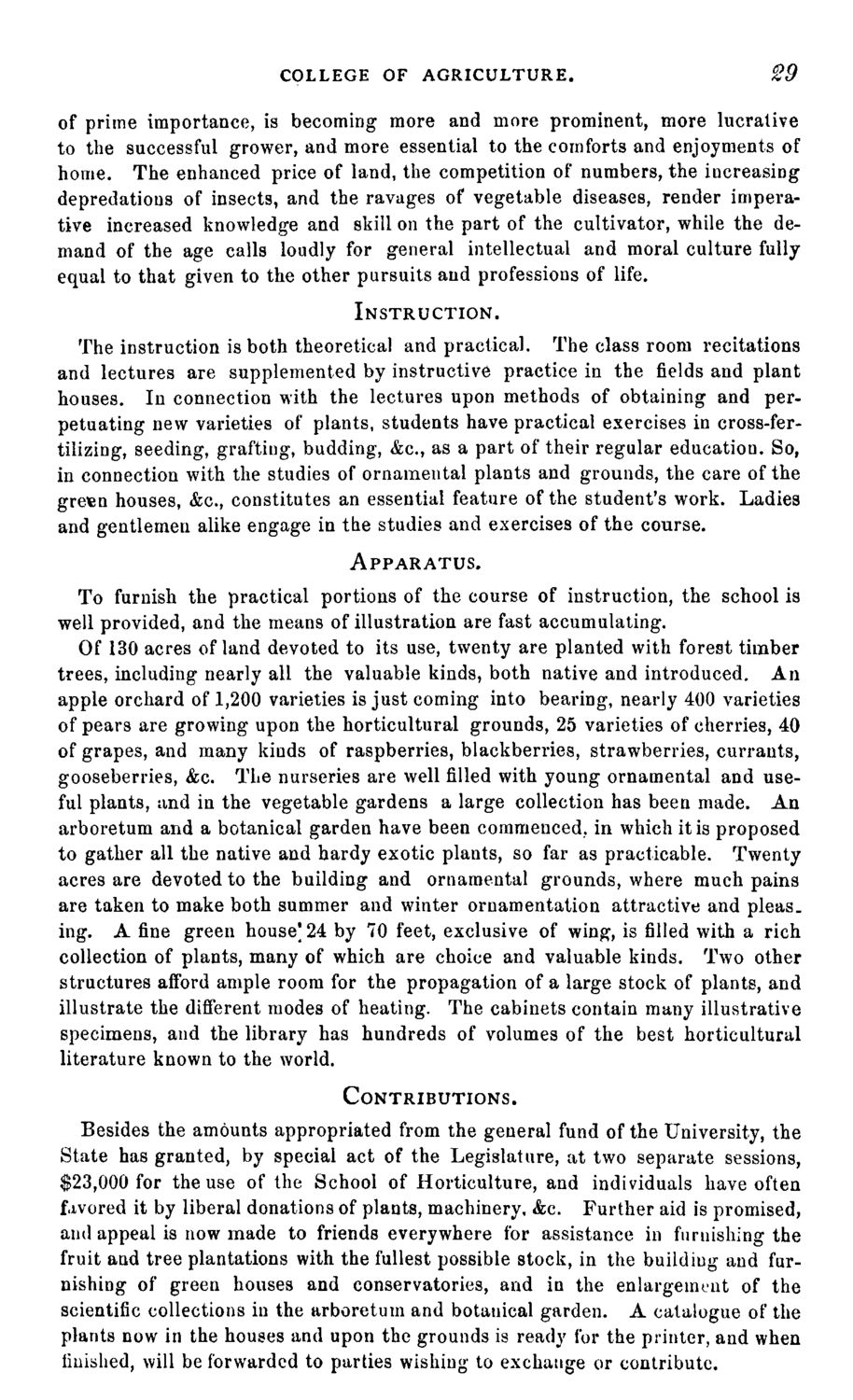| |
| |
Caption: Course Catalog - 1871-1872
This is a reduced-resolution page image for fast online browsing.

EXTRACTED TEXT FROM PAGE:
COLLEGE OF AGRICULTURE. 29 of prime importance, is becoming more and more prominent, more lucrative to the successful grower, and more essential to the comforts and enjoyments of home. The enhanced price of land, the competition of numbers, the increasing depredations of insects, and the ravages of vegetable diseases, render imperative increased knowledge and skill on the part of the cultivator, while the demand of the age calls loudly for general intellectual and moral culture fully equal to that given to the other pursuits and professions of life. INSTRUCTION. The instruction is both theoretical and practical. The class room recitations and lectures are supplemented by instructive practice in the fields and plant houses. In connection with the lectures upon methods of obtaining and perpetuating new varieties of plants, students have practical exercises in cross-fertilizing, seeding, grafting, budding, &c, as a part of their regular education. So, in connection with the studies of ornamental plants and grounds, the care of the gre«n houses, &c, constitutes an essential feature of the student's work. Ladies and gentlemen alike engage in the studies and exercises of the course. APPARATUS. To furnish the practical portions of the course of instruction, the school is well provided, and the means of illustration are fast accumulating. Of 130 acres of land devoted to its use, twenty are planted with forest timber trees, including nearly all the valuable kinds, both native and introduced. An apple orchard of 1,200 varieties is just coming into bearing, nearly 400 varieties of pears are growing upon the horticultural grounds, 25 varieties of cherries, 40 of grapes, and many kinds of raspberries, blackberries, strawberries, currants, gooseberries, &c. The nurseries are well filled with young ornamental and useful plants, and in the vegetable gardens a large collection has been made. An arboretum and a botanical garden have been commenced, in which it is proposed to gather all the native and hardy exotic plants, so far as practicable. Twenty acres are devoted to the building and ornamental grounds, where much pains are taken to make both summer and winter ornamentation attractive and pleas, ing. A fine green house' 24 by 70 feet, exclusive of wing, is filled with a rich collection of plants, many of which are choice and valuable kinds. Two other structures afford ample room for the propagation of a large stock of plants, and illustrate the different modes of heating. The cabinets contain many illustrative specimens, and the library has hundreds of volumes of the best horticultural literature known to the world. CONTRIBUTIONS. Besides the amounts appropriated from the general fund of the University, the State has granted, by special act of the Legislature, at two separate sessions, $23,000 for the use of the School of Horticulture, and individuals have often favored it by liberal donations of plants, machinery, &c. Further aid is promised, and appeal is now made to friends everywhere for assistance in furnishing the fruit and tree plantations with the fullest possible stock, in the building and furnishing of green houses and conservatories, and in the enlargement of the scientific collections in the arboretum and botanical garden. A catalogue of the plants now in the houses and upon the grounds is ready for the printer, and when iinislied, will be forwarded to parties wishing to exchange or contribute.
| |